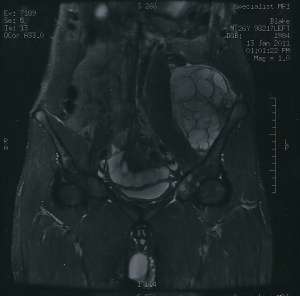Chondrosarcoma
Background[1]
- Third most common primary bone malignancy after multiple myeloma and osteosarcoma
- Around ninety percent of chondrosarcomas are of low metastatic potential
- Osteochondromas and enchondromas can be precursors lesions
Pathophysiology
- Overproduction of chondroid matrix in the medullary cavity
Clinical Features
- Lesions commonly in the pelvis and central skeleton
- Occurs in patients over 40 years-old with a male predominance
- Often will present with local swelling and pain or a pathologic fracture
- Very slow growing tumors
Differential Diagnosis
Malignant
- Multiple myeloma
- Chondrosarcoma
- Paget disease
- Osteosarcoma
- Adamantinoma
- Chordoma
- Primary bone lymphoma
- Fibrosarcoma
- Myosarcoma
Benign
- Giant cell tumor
- Chrondroblastoma
- Enchondroma
- Langerhans cell histiocytosis of bone
- Osteoblastoma
- Osteochondroma
- Osteoid osteoma
Evaluation

MRI of a left-pelvis with chondrosarcoma
- Plain radiographs reveal punctate calcifications and cortical bone destruction
- CT or MRI to assess extent of bone involvement
- Bone biopsy for definitive diagnosis
Management
- Surgery is the definitive treatment
- Radiation and chemotherapy are ineffective as tumor is very slow growing
Disposition
- Home with outpatient follow up
References
- Niederhuber, John E., et al. “Sarcomas.” Abeloff's Clinical Oncology E-Book. Elsevier Health Sciences, 2019, pp. 1604 – 1654.e8.
This article is issued from
Wikem.
The text is licensed under Creative
Commons - Attribution - Sharealike.
Additional terms may apply for the media files.